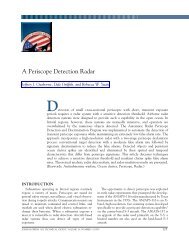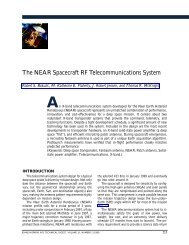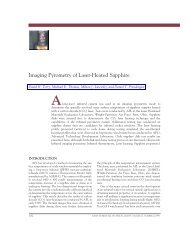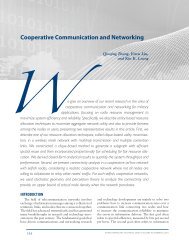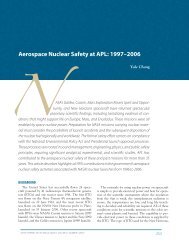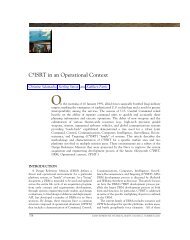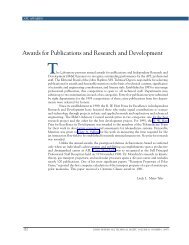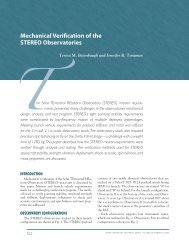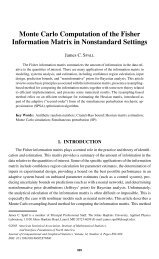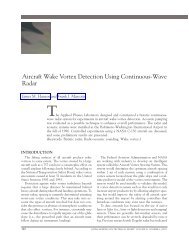Tomahawk Deconfliction - The Johns Hopkins University Applied ...
Tomahawk Deconfliction - The Johns Hopkins University Applied ...
Tomahawk Deconfliction - The Johns Hopkins University Applied ...
Create successful ePaper yourself
Turn your PDF publications into a flip-book with our unique Google optimized e-Paper software.
A. F. POLLACK, R. C. FERGUSON, AND A. K. CHRYSOSTOMOU<br />
Deterministic missile offset assignment is simple in<br />
a centralized scheme. Information is available about all<br />
of the missiles so they can be assigned unique offsets.<br />
In a distributed scheme, information is much more<br />
limited. Each missile must independently select an<br />
offset without knowing the number of missiles sharing<br />
the route. After considering the information available<br />
to each missile, the assignment scheme focused on the<br />
launch time and launch location. <strong>The</strong> minimum separation<br />
between missile launch times for a single shooter<br />
defines a time interval. A set of these time intervals<br />
is associated with each missile offset in a repeating<br />
pattern. <strong>The</strong> minimum separation between missiles<br />
from the same shooter sharing an offset is equal to the<br />
number of intervals multiplied by the time interval.<br />
Thus, the launch time deconflicts missiles from a single<br />
shooter. When multiple shooters are involved in a<br />
strike, the possibility exists for simultaneous missile<br />
firings. To prevent these missiles from sharing the same<br />
offset, the placement of the initial offset depends upon<br />
launch platform location. This randomizes offset selection<br />
between different shooters, reducing the probability<br />
of two closely spaced missiles sharing an offset.<br />
Monte Carlo simulations indicate that this distributed<br />
deterministic allocation algorithm can achieve the<br />
required reduction in probability of collision.<br />
<strong>The</strong> probability of collision reduction depends upon<br />
the size and number of offsets. To avoid increasing the<br />
probability of missile clobber, the overall width of the<br />
cross-track corridor is limited by the size of the mission<br />
planning analysis corridor. <strong>The</strong> conservative mission<br />
planning analysis corridor analyzes more ground for<br />
probability of clobber than is required for GPS accuracy.<br />
This additional analyzed terrain is used for crosstrack<br />
offsets, thereby maintaining the overall probability<br />
of clobber. Vertical offsets involve a trade-off<br />
between probability of collision and missile survivability.<br />
Simulations demonstrated that a relatively small<br />
vertical offset can dramatically reduce the probability<br />
of collision. <strong>The</strong> impact on missile survivability is<br />
minimal since vertical offsets are small and are removed<br />
before the missile reaches the terminal area where<br />
heavy defenses are most likely. Only positive vertical<br />
offsets are used, resulting in increased altitude that<br />
maintains or reduces the probability of clobber.<br />
Once the overall size of the corridor available for<br />
offsets is fixed, the number of cross-track and vertical<br />
offsets must be determined. A Monte Carlo simulation<br />
was developed to analyze the probability of collision for<br />
different numbers of offsets based on different scenarios.<br />
<strong>The</strong> scenario definition included setting the number of<br />
missiles, number of launch platforms, and platform<br />
firing rates. Based on simulation results, a grid of<br />
seven cross-track offsets by three vertical offsets was<br />
established.<br />
Offset insertion and removal is influenced by the<br />
probability of collision and the probability of navigation<br />
update. Since GPS accuracy is responsible for the<br />
increased probability of collision, the offset is inserted<br />
upon GPS acquisition. To avoid reducing the missile’s<br />
chance of achieving a navigation fix, the offsets are<br />
removed before the first Digital Scene Matching Area<br />
Correlator (DSMAC) scene is used. For missions without<br />
DSMAC, the offsets are removed before the target<br />
area is reached.<br />
A final consideration involves the impact of TOT<br />
control on deconfliction. TOT control allows a missile<br />
to control its speed during flight to arrive at the target<br />
at a specified time. If multiple missiles are trying to be<br />
in the exact same place at the exact same time, especially<br />
for long distances, the probability of collision is<br />
high. <strong>The</strong> en route offsets help to prevent collision<br />
during most of the flight; however, the offsets must be<br />
removed in the terminal area before the target is<br />
reached. If the missiles are aimed at the same point, the<br />
only possible method of deconfliction is assigning the<br />
missiles a TOT separation. Minimizing the size of<br />
the separation is critical to maintaining <strong>Tomahawk</strong>’s<br />
tactical flexibility. <strong>The</strong> minimum required separation is<br />
based on TOT control accuracy, potential aerodynamic<br />
interactions, engine performance differences, target<br />
area considerations, and the possibility of terminal<br />
fratricide.<br />
<strong>The</strong> second-phase deconfliction solution was implemented,<br />
tested, and delivered to the Fleet less than a<br />
year after the deconfliction analysis was started, and the<br />
solution achieved all four primary goals. It met the cost<br />
and schedule containment goals, and deconfliction<br />
using automatic missile operational flight software<br />
enabled very simple guidance (Fig. 5) that minimized<br />
the effect on operators and maintained full operational<br />
effectiveness. Analysis of the solution reveals that the<br />
deconfliction measures installed in the Fleet reduce the<br />
probability of collision by an order of magnitude, returning<br />
it to the levels of the <strong>Tomahawk</strong> Block II<br />
missile, when the Big Sky-Little Missile theory was<br />
adequate. <strong>The</strong> solution thus reduced collision probabilities<br />
to acceptable levels.<br />
CONTINUED DECONFLICTION<br />
EFFORTS<br />
As Technical Direction Agent for <strong>Tomahawk</strong>, APL’s<br />
work extends beyond the initial delivery of an analysis,<br />
product, or solution. Part of our responsibility is to<br />
continue to monitor the evolution of the <strong>Tomahawk</strong><br />
weapon system to assure that all the pieces continue to<br />
work together properly. Because APL is involved with<br />
the system at so many different levels, we have a unique<br />
perspective on <strong>Tomahawk</strong>, enabling us to identify<br />
86 JOHNS HOPKINS APL TECHNICAL DIGEST, VOLUME 18, NUMBER 1 (1997)



